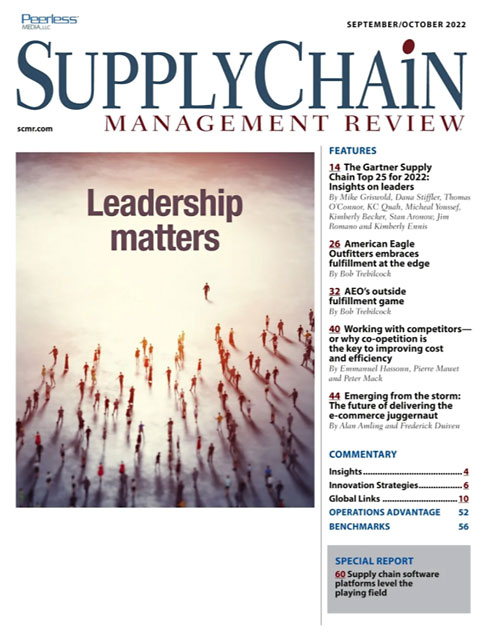Sorry, but your login has failed. Please recheck your login information and resubmit. If your subscription has expired, renew here.
September-October 2022
Once again, it’s time for Gartner’s Top 25 supply chains, the annual list of the 25 supply chains that have made it to the top, plus five Masters that have consistently outperformed year after year. You can read the article, along with some web-only material on scmr.com, to find out what it takes to become a supply chain leader. Last year, I was struck by how the leaders were embracing ESG, or Environmental, Social, & Governance. That has only been reinforced in this year’s report. In fact, ESG has been on the agenda of every event I’ve attended this year, including the keynote address at this year’s ISM conference. Whatever is the… Browse this issue archive.Need Help? Contact customer service 847-559-7581 More options
Without a doubt, e-commerce has hit an inflection point.
Not long ago, the Adobe Digital Economy Index noted that “After two years of the pandemic (March 2020 through February 2022), U.S. consumers spent $1.7 trillion online, $609 billion more than the two preceding years.” Last year alone, Adobe pegged e-commerce consumer spending at $885 billion, and expects that to surpass $1 trillion this year.
Those numbers, Adobe says, are based on an analysis of one trillion visits to U.S. retail e-commerce sites and 100 million SKUs in 18 product categories from apparel to food.
While total e-commerce sales continue to trend up, the pace of that growth has been erratic at best. Adjusted e-commerce sales in the first quarter of 2021 were 46.7% above year earlier numbers, according to the U.S. Census Bureau, yet rose just 6.6% for the first quarter of 2022 compared to the same quarter of 2021.
Moreover, the Census Bureau reports that first quarter 2022 e-commerce sales as a percent of all retail sales came in at 14.3%, a slight drop from the 14.9% share reported just one year earlier. Yes, you read that correctly. E-commerce sales as a share of all retail has actually declined a bit. Even Amazon is scaling back its growth plans. About the time that Adobe and the Census Bureau reported, Amazon revealed that it quickly transitioned from being understaffed in the fourth quarter of 2021 to being overstaffed in the first quarter of 2022. To put this in perspective, however, Amazon hired more than 270,000 people in the second half of 2021 (Washington Post 5-5-22). And while Amazon is scaling back its logistics buildout in 2022, the company is still expected to open about 250 more facilities this year.

This complete article is available to subscribers only.
Log in now for full access or start your PLUS+ subscription for instant access.
SC
MR
Sorry, but your login has failed. Please recheck your login information and resubmit. If your subscription has expired, renew here.
September-October 2022
Once again, it’s time for Gartner’s Top 25 supply chains, the annual list of the 25 supply chains that have made it to the top, plus five Masters that have consistently outperformed year after year. You can read… Browse this issue archive. Access your online digital edition. Download a PDF file of the September-October 2022 issue.Without a doubt, e-commerce has hit an inflection point.
Not long ago, the Adobe Digital Economy Index noted that “After two years of the pandemic (March 2020 through February 2022), U.S. consumers spent $1.7 trillion online, $609 billion more than the two preceding years.” Last year alone, Adobe pegged e-commerce consumer spending at $885 billion, and expects that to surpass $1 trillion this year.
Those numbers, Adobe says, are based on an analysis of one trillion visits to U.S. retail e-commerce sites and 100 million SKUs in 18 product categories from apparel to food.
While total e-commerce sales continue to trend up, the pace of that growth has been erratic at best. Adjusted e-commerce sales in the first quarter of 2021 were 46.7% above year earlier numbers, according to the U.S. Census Bureau, yet rose just 6.6% for the first quarter of 2022 compared to the same quarter of 2021.
Moreover, the Census Bureau reports that first quarter 2022 e-commerce sales as a percent of all retail sales came in at 14.3%, a slight drop from the 14.9% share reported just one year earlier. Yes, you read that correctly. E-commerce sales as a share of all retail has actually declined a bit. Even Amazon is scaling back its growth plans. About the time that Adobe and the Census Bureau reported, Amazon revealed that it quickly transitioned from being understaffed in the fourth quarter of 2021 to being overstaffed in the first quarter of 2022. To put this in perspective, however, Amazon hired more than 270,000 people in the second half of 2021 (Washington Post 5-5-22). And while Amazon is scaling back its logistics buildout in 2022, the company is still expected to open about 250 more facilities this year.
SC
MR


More 3PL
- Services sector sees growth in October, reports ISM
- Managing inbound freight: What has changed in two decades?
- Inbound freight: Often a missed opportunity
- 2024 Warehouse/DC Operations Survey: Technology adoption on the rise
- Looking back at NextGen 2024
- Manufacturing again contracts in October, reports ISM
- More 3PL
Latest Podcast

 Explore
Explore
Business Management News
- Made in Mexico, manufactured by China
- Retail sales see gains in October, reports Commerce and NRF
- Balancing green and speed: Home delivery insights from the pandemic era
- AdventHealth named top healthcare supply chain by Gartner
- Unlocking retention: The role employee engagement plays
- Can supply chain managers embrace an entrepreneurial mindset?
- More Business Management
Latest Business Management Resources

Subscribe

Supply Chain Management Review delivers the best industry content.

Editors’ Picks





